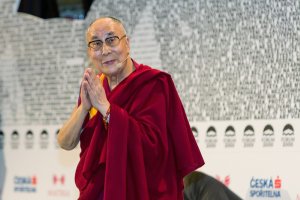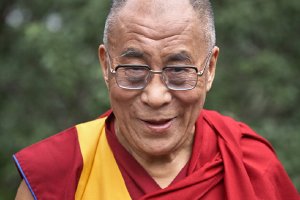Shortly after he turned 87 on July 6, the Dalai Lama traveled to Ladakh, a remote, high-altitude region of India that borders China and is steeped in Tibetan culture.

Tibet’s spiritual leader received a rousing reception as he was driven July 15 from the airport in Ladakh’s capital, Leh, to his summer palace, where he is scheduled to stay for about a month and a half.
Some 20,000 people, including many from the community of roughly 7,000 Tibetans who live in exile in Ladakh, lined both sides of the road as the Dalai Lama and his entourage slowly made their way through the joyous crowds. People waved Tibetan and religious flags and showered the road with flower petals to welcome him.
It was the first time since the COVID-19 pandemic that the Dalai Lama ventured outside Dharamshala, a Himalayan town in India where his government-in-exile has been based since he fled Tibet in 1959 following China’s 1950 invasion and occupation of his country.
Over the decades, the Dalai Lama has frequently visited Ladakh, whose picturesque, wind-swept landscape resembles Tibet and is dotted with mountain-top Buddhist monasteries known as gompas.
His latest visit is also the Dalai Lama’s first since the government of India revoked Kashmir’s partial political autonomy in 2019 and split the state into two federal territories: the Jammu and Kashmir Territory and Ladakh. India then assumed direct federal control of both territories.
The abrogation of Ladakh’s special status raised apprehensions among Ladakhis that they might lose their land, employment and distinct identity. The majority of them are Muslim, not Buddhist as outsiders often mistakenly assume. Buddhism is the second-largest religious group.
Just a year after this change in status, India and China narrowly averted full-scale war in Ladakh and have since been locked in a military face-off.
Tensions flared once again when China, which does not recognize the Dalai Lama’s Tibetan government-in-exile and has not held any dialogue with his representatives since 2010, objected to Indian Prime Minister Narendra Modi greeting the Dalai Lama on his 87th birthday. The gesture, Beijing said, amounted to interference in China’s “internal affairs.”
The Indian Foreign Ministry responded, “It has been a consistent policy of our government to treat him [the Dalai Lama] as a guest in India and as a respected religious leader who enjoys a large following in India.”
“India and China are both competitive nations and neighbors,” the Dalai Lama said about the conflict. “Sooner or later you have to solve this problem through talks and peaceful means. The use of military force is outdated.”
_______________
From its beginnings, the Church of Scientology has recognized that freedom of religion is a fundamental human right. In a world where conflicts are often traceable to intolerance of others’ religious beliefs and practices, the Church has, for more than 50 years, made the preservation of religious liberty an overriding concern.
The Church publishes this blog to help create a better understanding of the freedom of religion and belief and provide news on religious freedom and issues affecting this freedom around the world.
The Founder of the Scientology religion is L. Ron Hubbard and Mr. David Miscavige is the religion’s ecclesiastical leader.
For more information visit the Scientology website or Scientology Network.


